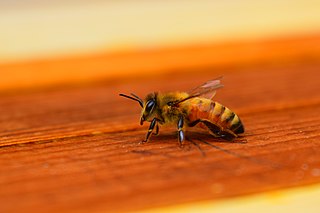
A honey bee is a eusocial flying insect within the genus Apis of the bee clade, all native to mainland Afro-Eurasia. After bees spread naturally throughout Africa and Eurasia, humans became responsible for the current cosmopolitan distribution of honey bees, introducing multiple subspecies into South America, North America, and Australia.
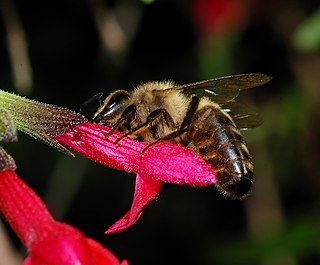
The Apis mellifera mellifera is a subspecies of the western honey bee, evolving in central Asia, with a proposed origin of the Tien Shan Mountains and later migrating into eastern and then northern Europe after the last ice age from 9,000BC onwards. Its original range included the southern Urals in Russia and stretched through northern Europe and down to the Pyrenees. They are one of the two members of the 'M' lineage of Apis mellifera, the other being in western China. Traditionally they were called the Black German Bee, although they are now considered endangered in Germany. However today they are more likely to be called after the geographic / political region in which they live such as the British Black Bee, the Native Irish Honey Bee, the Cornish Black Bee and the Nordic Brown Bee, even though they are all the same subspecies, with the word "native" often inserted by local beekeepers, even in places where the bee is an introduced foreign species. It was domesticated in Europe and hives were brought to North America in the colonial era in 1622 where they were referred to as the English Fly by the Native Americans.
Nosema apis is a microsporidian, a small, unicellular parasite recently reclassified as a fungus that mainly affects honey bees. It causes nosemosis, also called nosema, which is the most common and widespread of adult honey bee diseases. The dormant stage of N. apis is a long-lived spore which is resistant to temperature extremes and dehydration, and cannot be killed by freezing the contaminated comb. Nosemosis is a listed disease with the Office International des Epizooties (OIE).

Varroa destructor, the Varroa mite, is an external parasitic mite that attacks and feeds on honey bees and is one of the most damaging honey bee pests in the world. A significant mite infestation leads to the death of a honey bee colony, usually in the late autumn through early spring. Without management for Varroa mite, honey bee colonies typically collapse within 2 to 3 years in temperate climates. These mites can infest Apis mellifera, the western honey bee, and Apis cerana, the Asian honey bee. Due to very similar physical characteristics, this species was thought to be the closely related Varroa jacobsoni prior to 2000, but they were found to be two separate species after DNA analysis.

Varroa is a genus of parasitic mesostigmatan mites associated with honey bees, placed in its own family, Varroidae. The genus was named for Marcus Terentius Varro, a Roman scholar and beekeeper. The condition of a honeybee colony being infested with Varroa mites is called varroosis.

Varroa jacobsoni is a species of mite that parasitises Apis cerana. The more damaging Varroa destructor was previously included under the name V. jacobsoni, but the two species can be separated on the basis of the DNA sequence of the cytochrome oxidase I gene in the mitochondrial DNA.
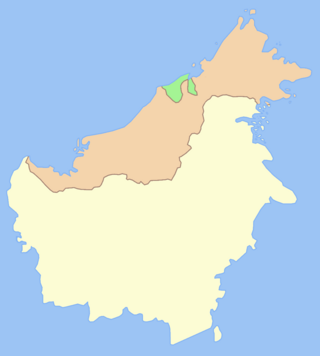
Apis cerana nuluensis is a subspecies of honey bee described in 1996 by Tingek, Koeniger & Koeniger. The geographic distribution of the subspecies is the southeastern Asian island of Borneo, politically divided between Indonesia, Malaysia, and Brunei.

Apis andreniformis, or the black dwarf honey bee, is a relatively rare species of honey bee whose native habitat is the tropical and subtropical regions of Southeast Asia.

Apis laboriosa or Himalayan giant honey bee, is the world's largest honey bee; single adults can measure up to 3.0 cm (1.2 in) in length. Before 1980, Apis laboriosa was considered to be a subspecies of the widespread Apis dorsata, the giant honey bee, but in 1980 and for almost 20 years thereafter it was elevated to the rank of a separate species. It was classified once again as a subspecies of Apis dorsata by Michael S. Engel in 1999, but was confirmed as a full species in 2020 on the basis of co-occurrence with Apis dorsata at many sites with no sign of interbreeding. It is highly adapted to its highland habitat in behavior.

Apis koschevnikovi, Koschevnikov's honey bee, is a species of honey bee which inhabits Malaysian and Indonesian Borneo, where it lives sympatrically with other honey bee species such as Apis cerana.

Apis nigrocincta is a species of honey bee that inhabits the Philippine island of Mindanao as well as the Indonesian islands of Sangihe and Sulawesi. The species is known to have queens with the highest mating frequencies of any species of the tribe Apini.

Apis dorsata, the rock bee or giant honey bee, is a honey bee of South and Southeast Asia. They are typically around 17–20 mm (0.7–0.8 in) long and nests are mainly built in exposed places far off the ground, like on tree limbs, under cliff overhangs, and under buildings. These social bees are known for their aggressive defense strategies and vicious behavior when disturbed. Though not domesticated, indigenous peoples have traditionally used this species as a source of honey and beeswax, a practice known as honey hunting.

Apis cerana, the eastern honey bee, Asiatic honey bee or Asian honey bee, is a species of honey bee native to South, Southeast and East Asia. This species is the sister species of Apis koschevnikovi and both are in the same subgenus as the western (European) honey bee, Apis mellifera. A. cerana is known to live sympatrically along with Apis koschevnikovi within the same geographic location. Apis cerana colonies are known for building nests consisting of multiple combs in cavities containing a small entrance, presumably for defense against invasion by individuals of another nest. The diet of this honey bee species consists mostly of pollen and nectar, or honey. Moreover, Apis cerana is known for its highly social behavior, reflective of its classification as a type of honey bee.
Varroa sensitive hygiene (VSH) is a behavioral trait of honey bees (Apis mellifera) in which bees detect and remove bee pupae that are infested by the parasitic mite Varroa destructor. V. destructor is considered to be the most dangerous pest problem for honey bees worldwide. VSH activity results in significant resistance to the mites.
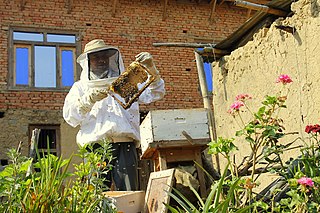
Nepal is known for its ancestral technology of beekeeping: geographical conditions and lack of modern equipment have forced the collectors to risk their lives. Apiculture in Nepal began 20 years ago but is still not very developed. Different species of honey-producing bees are found in Nepal. Only two of them are raised for apiculture: Apis cerana,Apis mellifera and Apis florea. These species have several qualities that are desired by humans and are vital for the pollination of flowers and forests. Bees are also useful for agriculture which is an important activity in Nepal but they have become threatened by deforestation and parasites.
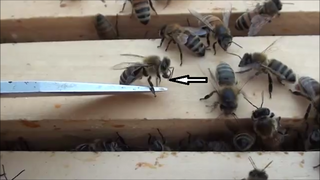
Mite Biting Is one of the behavioral mechanisms of honey bees used to fight off the ectoparasitic mites Varroa destructor. This behavior has been studied since the late 1990s for honey bee breeding and improvement of honeybee stocks towards mite resistance. Krispn Given and Dr. Greg Hunt at Purdue University started a hierarchical selective breeding program in 1997–present for increased mite-biting and grooming behavior of European honey bee. A group of Midwest bee breeders visiting the Purdue bee lab were inspired to start the Heartland Honey Bee Breeders Cooperative as a result of their pioneering work.
Friedrich Ruttner was an Austrian SA-member, NSDAP member, SS-physician, neurologist, zoologist and bee expert. He became internationally known for his advances in honey bee breeding, instrumental insemination, classification of various subspecies and as a co-founder of Apidologie.
Varroa rindereri is an external parasitic mite that feeds on honey bees. The only known honey bee species it feeds on is Apis koschevnikovi












